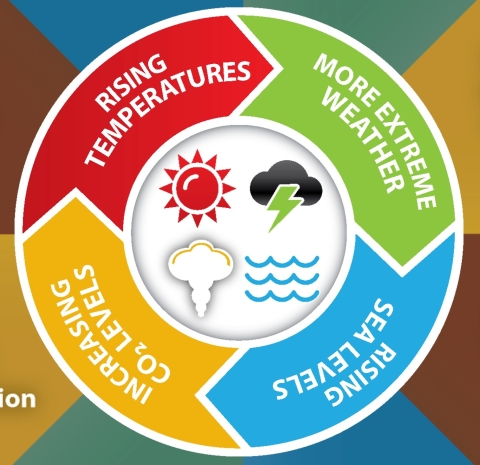We need some warmth to survive on this planet which sits next to the cold uninhabitable space, so thank you greenhouse gasses. But aren’t greenhouse gasses bad? As in many aspects of medicine: it depends. Carbon dioxide, methane, and nitrous oxide live in our atmosphere reflecting reradiated heat energy from our planet that comes from solar radiation hitting earth’s surface. Normally, this balance keeps us at a nice temperature but as we increase our greenhouse gasses in the atmosphere more of this reradiated heat energy stays in our atmosphere and is not lost into space. Many have described this as global warming, but a more accurate portrayal is an energized planet. Earth’s normal energy budget allows for this solar energy from the sun to be captured and released by our planet’s atmosphere and surface. Yet our energy budget is now adding more energy each year. Stored energy in our planet has to go somewhere thus the energy changes form and becomes heat. This heat dissipates across our planet with about 90% going into our oceans causing them to warm with the rest going into land, atmosphere and ice formations. The disease of our planet is one of too much energy, caused by the release of stored carbon and increased atmospheric greenhouse gasses from the consumption of fossil fuels and destruction of natural carbon stores. Simple enough but how does this affect our health?
As this heat energy is absorbed, there are four major mechanisms that lead to human disease: rising temperatures, more extreme weather, increased carbon dioxide levels and rising sea levels. These pathophysiological mechanisms are much more approachable than some cytokine or interleukin cellular processes. Higher temps, crazy storms, CO2 everywhere and oceans rising- got it! Let’s dive into some of the details for each of these 4 areas and you will notice there is overlap in such an interconnected system.
Higher temperatures sound great in the middle of winter, maybe. However, we are experiencing longer summers, with more days above average temperatures and more extreme hot days than extreme cold days. Imagine the bell curve of daily temperatures. This curve has shifted toward the hotter side. There will still be cold days at the edges of the bell curve but there will be more days above normal temperature and extreme heat days than those below normal temperature. How does this impact our patients? A Harvard study showed that every 1 Celcius (C) increase in temperature in summer increased death rates in elderly with chronic medical conditions like diabetes, heart disease and chronic lung disease by 3-4%. Another way to look at this is the number needed to harm is 30 for death in this population. You could also think of it as not allowing the 1 degree C rise, the number needed to treat is 30 for mortality, which is better than almost every drug those patients would be on! So there is some value to preventing temperature rise? Temperature rise is amplified by the heat island effect as >50% of our planet’s population lives in cities compared to <30% a few decades ago. Increasing hardscape such as roads, parking lots, buildings, factories and commercial centers replaces the natural grass, trees and dirt. These hardened structures absorb and re-emit more energy during the day from the sun. We call this process the heat island effect where higher temperatures exist in the city than in the surrounding rural area. Besides the direct effect of heat creating dehydration and heat stroke, higher temperatures increase cardiovascular events, respiratory disease and mental illness.
Working hand and hand with higher temperatures is extreme weather. Extreme weather is a force multiplier to the medically vulnerable- lower socioeconomic status, pre existing illness and extremes of age. Whether in the form of storms, floods, droughts or heat waves, this leads to destruction of property, livelihoods, food and water insecurity, infectious disease, and trauma, both mental and physical. These storms can lead to financial ruin or forced migration for humans. Flooding leads to a “fecal veneer” that blankets a flooded area where clean and dirty were separated by infrastructure. Floods wash all the sewage and agricultural fields together leading to contaminated food and water. When combined with a high temperature, an algal blooms is produced which can poison humans and contaminate fisheries. Our impacts on Mother Nature can come back to bite us pretty hard.
Flooding can not only come from extreme weather, but from rising sea levels. Rising temperatures lead to ocean warming, melting ice and decrease in Northern hemisphere snow cover. Besides releasing stored fresh water, this releases carbon from these thick ice sheets. All this creates less reflective white surfaces and more dark surfaces of water/land. Decreased reflection compounds the impact in the refractive effect of solar radiation, further energizing our planet. Glaciers hold 2.1% of all the water in the planet. Melting glaciers will affect the world’s population as 40% of humans live within 100 kilometers of an ocean. Sea level change is not happening equally because the Antarctic ice sheet has its own gravitational force. Currents move east to west therefore Maryland will have higher sea level rise than California. Rising sea levels can lead to displacement, property loss, infectious disease and financial burdens, and could affect up to 50 million people by 2100.
Worldwide consequences from rising oceans, higher temps and crazy storms are all driven by CO2 everywhere from human actions leading to release of stored CO2. Treating this core pathophysiologic principle will lead to better outcomes for our patients and planet. Put all the CO2 back into storage- got it. Simple conceptually but harder to enact. Our planet’s energy budget requires us to decrease our production of CO2 and increase re-capturing CO2. This will decrease the extra energy our planet is taking on each year and lead to a cure for our planet’s disease impacting our patients.



